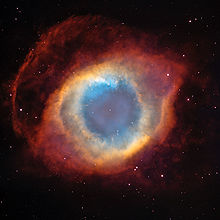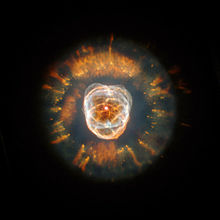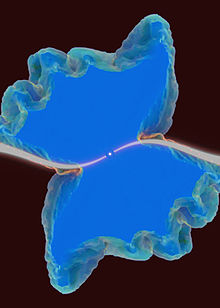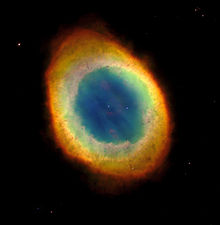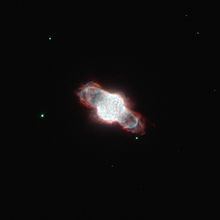
Planetary nebula
About this schools Wikipedia selection
Arranging a Wikipedia selection for schools in the developing world without internet was an initiative by SOS Children. SOS Children is the world's largest charity giving orphaned and abandoned children the chance of family life.
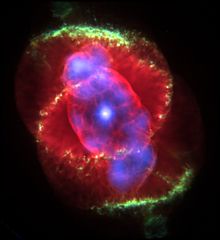
A planetary nebula, more correctly known as a stellar-remnant nebula , is an emission nebula consisting of an expanding glowing shell of ionized gas ejected during the asymptotic giant branch phase of certain types of stars late in their life. The term for this class of objects is a misnomer that originated in the 1780s with astronomer William Herschel, because when viewed through his telescope, these objects were somewhat similar in appearance to Uranus, the planet which he had recently discovered. Herschel's name for these objects was adopted by astronomers and has not been changed, even though planetary nebulae are unrelated to the planets of the solar system. They are a relatively short-lived phenomenon, lasting a few tens of thousands of years, compared to a typical stellar lifetime of several billion years.
The mechanism for formation of most planetary nebulae is thought to be the following: at the end of the star's life, during the red giant phase, the outer layers of the star are expelled via pulsations and strong stellar winds. Without these opaque layers, the hot, luminous core emits ultraviolet radiation that ionizes the ejected outer layers of the star. This energized shell radiates as a planetary nebula.
Planetary nebulae play a crucial role in the chemical evolution of the galaxy, returning material to the interstellar medium that has been enriched in heavy elements and other products of nucleosynthesis (such as carbon, nitrogen, oxygen and calcium). In more distant galaxies, planetary nebulae may be the only objects that can be resolved to yield useful information about chemical abundances.
In recent years, Hubble Space Telescope images have revealed many planetary nebulae to have extremely complex and varied morphologies. About a fifth are roughly spherical, but the majority are not spherically symmetric. The mechanisms which produce such a wide variety of shapes and features are not yet well understood, but binary central stars, stellar winds and magnetic fields may all play a role.
Observations
Planetary nebulae are generally faint objects; none are visible to the naked eye. The first planetary nebula discovered was the Dumbbell Nebula in the constellation of Vulpecula, observed by Charles Messier in 1764 and listed as M27 in his catalogue of nebulous objects. To early observers with low-resolution telescopes, M27 and subsequently discovered planetary nebulae somewhat resembled the giant planets like Uranus, and William Herschel, discoverer of this planet, eventually coined the term 'planetary nebula' for them.
The nature of planetary nebulae was unknown until the first spectroscopic observations were made in the mid-19th century. William Huggins was one of the earliest astronomers to study the optical spectra of astronomical objects, using a prism to disperse their light. On August 29, 1864, Huggins was the first to take the spectrum of a planetary nebula when he analyzed NGC 6543. His observations of stars showed that their spectra consisted of a continuum with many dark lines superimposed on them, and he later found that many nebulous objects such as the Andromeda Nebula (as it was then known) had spectra which were quite similar to this—these nebulae were later shown to be galaxies.
However, when he looked at the Cat's Eye Nebula, he found a very different spectrum. Rather than a strong continuum with absorption lines superimposed, the Cat's Eye Nebula and other similar objects showed only a small number of emission lines. The brightest of these was at a wavelength of 500.7 nanometres, which did not correspond with a line of any known element. At first it was hypothesized that the line might be due to an unknown element, which was named nebulium—a similar idea had led to the discovery of helium through analysis of the Sun's spectrum in 1868.
While helium was isolated on earth soon after its discovery in the spectrum of the sun, nebulium was not. In the early 20th century Henry Norris Russell proposed that rather than being a new element, the line at 500.7 nm was due to a familiar element in unfamiliar conditions.
Physicists showed in the 1920s that in gas at extremely low densities, electrons can populate excited metastable energy levels in atoms and ions which at higher densities are rapidly de-excited by collisions. Electron transitions from these levels in nitrogen and oxygen ions (O2+ or OIII, O+ and N+) give rise to the 500.7 nm line and other lines. These spectral lines, which can only be seen in very low density gases, are called forbidden lines. Spectroscopic observations thus showed that nebulae were made of extremely rarefied gas.
The central stars of planetary nebulae are very hot. Only once a star has exhausted all its nuclear fuel can it collapse to such a small size, and so planetary nebulae came to be understood as a final stage of stellar evolution. Spectroscopic observations show that all planetary nebulae are expanding. This led to the idea that planetary nebulae were caused by a star's outer layers being thrown into space at the end of its life.
Towards the end of the 20th century, technological improvements helped to further the study of planetary nebulae. Space telescopes allowed astronomers to study light emitted beyond the visible spectrum which is not detectable from ground-based observatories (because only radio waves and visible light penetrate the Earth's atmosphere). Infrared and ultraviolet studies of planetary nebulae allowed much more accurate determinations of nebular temperatures, densities and abundances. Charge-coupled device technology allowed much fainter spectral lines to be measured accurately than had previously been possible. The Hubble Space Telescope also showed that while many nebulae appear to have simple and regular structures from the ground, the very high optical resolution achievable by a telescope above the Earth's atmosphere reveals extremely complex morphologies.
The youngest known planetary nebula is the Stingray Nebula.
Under the Morgan-Keenan spectral classification scheme, planetary nebulae are classified as Type-P, although this notation is seldom used in practice.
Origins
Stars more massive than 8 solar masses (M⊙) will likely end their lives in a dramatic supernova explosion. Planetary nebula may result from the death of intermediate and low mass stars down to 0.8 M⊙.
Stars spend most of their lifetime shining as a result of nuclear fusion reactions that convert hydrogen to helium in the star's core. Outward pressure from fusion in the core balances inward collapse due to the star's own gravity. Such stars are said to be in the main sequence.
Intermediate to low mass stars run out of hydrogen in their cores after tens of millions to billions of years in the main sequence. Gravity compresses the core and it heats up. Currently the sun's core has a temperature of approximately 15 million K, but when it runs out of hydrogen, the compression of the core will cause the temperature to rise to about 100 million K.
The outer layers of the star expand enormously and become much cooler in contrast to the very high temperature of the core; and the star becomes a red giant. The core continues to contract and heat up, and when its temperature reaches 100 million K, helium nuclei begin to fuse into carbon and oxygen. The resumption of fusion reactions stops the core's contraction. Helium burning (fusion of helium nuclei) soon forms an inert core of carbon and oxygen, with both a helium-burning shell and a hydrogen-burning shell surrounding it. In this last stage the star will observationally be a red giant again and structurally an asymptotic giant branch star.
Helium fusion reactions are extremely temperature sensitive, with reaction rates being proportional to T40 (under relatively low temperatures). This means that just a 2% rise in temperature more than doubles the reaction rate. These conditions cause the star to become very unstable—a small rise in temperature leads to a rapid rise in reaction rates, which releases a lot of energy, increasing the temperature further. The helium-burning layer rapidly expands and therefore cools, which reduces the reaction rate again. Huge pulsations build up, which eventually become large enough to throw off the whole stellar atmosphere into space.
The ejected gases form a cloud of material around the now-exposed core of the star. As more and more of the atmosphere moves away from the star, deeper and deeper layers at higher and higher temperatures are exposed. When the exposed surface reaches a temperature of about 30,000 K, there are enough ultraviolet photons being emitted to ionize the ejected atmosphere, making it glow. The cloud has then become a planetary nebula.
Lifetime
After the asymptotic giant branch (AGB) phase, the short planetary nebula phase of stellar evolution begins as gases drift away from the central star at speeds of a few kilometers per second. The central star is the remnant of its AGB progenitor, an electron-degenerate carbon-oxygen core that has lost most of its hydrogen envelope due to mass loss on the AGB. As the gases expand, the central star undergoes a two stage evolution, first growing hotter as it continues to contract and hydrogen fusion reactions occur in the shell around the core and then slowly cooling once the hydrogen shell is exhausted through fusion and mass loss. In the second phase, it radiates away its energy and fusion reactions cease, as the central star is not heavy enough to generate the core temperatures required for carbon and oxygen to fuse. During the first phase the central star maintains constant luminosity while, at the same time, it grows ever hotter, eventually reaching temperatures around 100,000 K. In the second phase, it eventually cools down so much that it does not give off enough ultraviolet radiation to ionize the increasingly distant gas cloud. The star becomes a white dwarf, and the expanding gas cloud becomes invisible to us, ending the planetary nebula phase of evolution. For a typical planetary nebula, about 10,000 years passes between its formation and recombination of the star.
Galactic recyclers
Planetary nebulae play a very important role in galactic evolution. The early universe consisted almost entirely of hydrogen and helium, but stars create heavier elements via nuclear fusion. The gases of planetary nebulae thus contain a large proportion of elements such as carbon, nitrogen and oxygen, and as they expand and merge into the interstellar medium, they enrich it with these heavy elements, collectively known as metals by astronomers.
Subsequent generations of stars which form will then have a higher initial content of heavier elements. Even though the heavy elements will still be a very small component of the star, they have a marked effect on its evolution. Stars which formed very early in the universe and contain small quantities of heavy elements are known as Population II stars, while younger stars with higher heavy element content are known as Population I stars (see stellar population).
Characteristics
Physical characteristics
A typical planetary nebula is roughly one light year across, and consists of extremely rarefied gas, with a density generally from 100 to 10,000 particles per cm3. (The Earth's atmosphere, by comparison, contains 2.5×1019 particles per cm3.) Young planetary nebulae have the highest densities, sometimes as high as 106 particles per cm3. As nebulae age, their expansion causes their density to decrease. The masses of planetary nebulae range from 0.1 to 1 solar masses.
Radiation from the central star heats the gases to temperatures of about 10,000 K. The gas temperature in central regions is usually much higher than at the periphery reaching 16,000–25,000 K. The volume in the vicinity of the central star is often filled with a very hot (coronal) gas having the temperature of about 1,000,000 K. This gas originates from the surface of the central star in the form of the fast stellar wind.
Nebulae may be described as matter bounded or radiation bounded. In the former case, there is not enough matter in the nebula to absorb all the UV photons emitted by the star, and the visible nebula is fully ionized. In the latter case, there are not enough UV photons being emitted by the central star to ionize all the surrounding gas, and an ionization front propagates outward into the circumstellar neutral envelope.
Numbers and distribution
About 3000 planetary nebulae are now known to exist in our galaxy, out of 200 billion stars. Their very short lifetime compared to total stellar lifetime accounts for their rarity. They are found mostly near the plane of the Milky Way, with the greatest concentration near the galactic centre.
Morphology
Only about 20% of planetary nebulae are spherically symmetric (for example, see Abell 39). A wide variety of shapes exist with some very complex forms seen. Planetary nebulae are classified by different authors into: stellar, disk, ring, irregular, helical, bipolar, quadrupolar, and other types, although the majority of them belong to just three types: spherical, elliptical and bipolar. The nebulae of the last type show the strongest concentration to the galactic plane and their progenitors are therefore relatively young massive stars. On the other hand spherical nebulae are likely produced by the old stars similar to the Sun.
The huge variety of the shapes is partially the projection effect—the same nebula when viewed under different angles will look differently. Nevertheless the reason for the huge variety of physical shapes is not fully understood, but may be caused by the gravitational interactions with companion stars if the central stars are double stars. Another possibility is that planets disrupt the flow of material away from the star as the nebula forms. It has been determined that the more massive stars produce more irregularly shaped nebulae. In January 2005, astronomers announced the first detection of magnetic fields around the central stars of two planetary nebulae, and hypothesized that the fields might be partly or wholly responsible for their remarkable shapes.
Membership in clusters
Planetary nebulae have been detected as members in four globular clusters: Messier 15, Messier 22, NGC 6441 and Palomar 6. However, there is currently only one established case of a planetary nebula discovered in an old Hyades-age open cluster as based on a consistent set of distances, reddenings, and radial velocities. The cases of NGC 2348 in Messier 46, and NGC 2818 in the respective open cluster that is designated by the same name, are often cited as bona fide instances, however, they are instead line-of-sight coincidences granted the radial velocities between the clusters and planetary nebulae are discrepant.
Partly because of their small total mass, open clusters have relatively poor gravitational cohesion. Consequently, open clusters tend to disperse after a relatively short time, typically from 100 to 600 million years, because of external gravitational influences amid other factors. Under exceptional conditions, open clusters can remain intact for up to one billion years or more.
Theoretical models predict that planetary nebulae can form from main-sequence stars of between eight and one solar masses, which puts their age at 40 million years and older. Although there are a few hundred known open clusters within that age range, a variety of reasons limit the chances of finding a member of an open cluster in a planetary nebula phase. One such reason is that the planetary nebula phase for more massive stars belonging to younger clusters is on the order of thousands of years—a blink of the eye in cosmic terms.
Current issues in planetary nebula studies
A long standing problem in the study of planetary nebulae is that in most cases, their distances are very poorly determined. For the nearest planetary nebulae, it is possible to determine distances by measuring their expansion parallax. High resolution observations taken several years apart will show the expansion of the nebula perpendicular to the line of sight, while spectroscopic observations of the Doppler shift will reveal the velocity of expansion in the line of sight. Comparing the angular expansion with the derived velocity of expansion will reveal the distance to the nebula.
The issue of how such a diverse range of nebular shapes can be produced is a controversial topic. It is believed that interactions between material moving away from the star at different speeds gives rise to most observed shapes. However, some astronomers believe that double central stars must be responsible for the more complex and extreme planetary nebulae. Several planetary nebulae have been shown to contain strong magnetic fields, something which has been hypothesized by Grigor Gurzadyan in the 1960s. Magnetic interactions with ionized gas could be responsible for shaping some planetary nebulae.
There are two methods of determining metal abundances in nebulae. These rely on different types of spectral lines—recombination lines and collisionally excited lines. Large discrepancies are sometimes seen between the results derived from the two methods. Some astronomers explain this by presence of small temperature fluctuations within planetary nebulae; others claim that the discrepancies are too large to be explained by temperature effects, and hypothesize the existence of cold knots containing very little hydrogen to explain the observations. However, no such knots have yet been observed.

